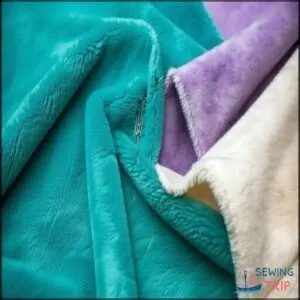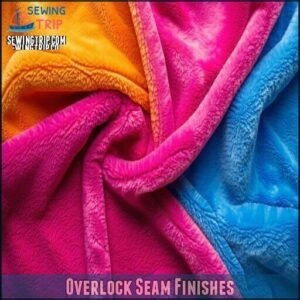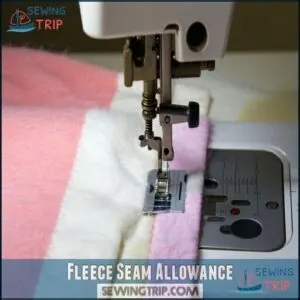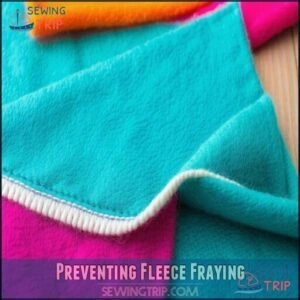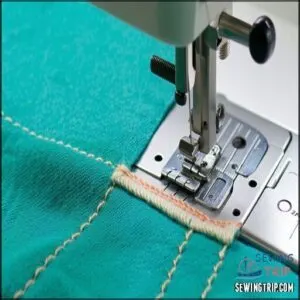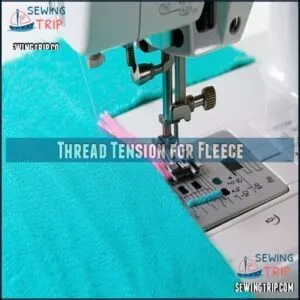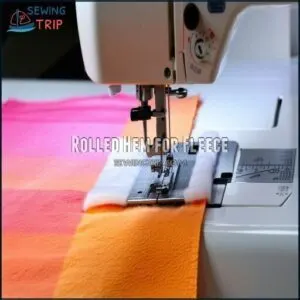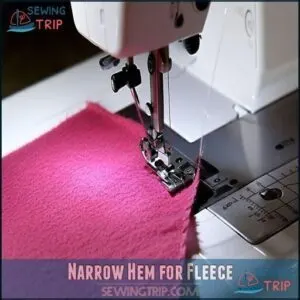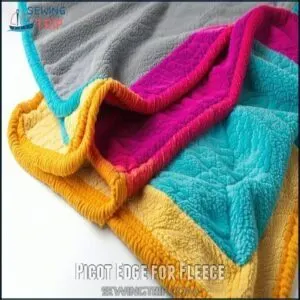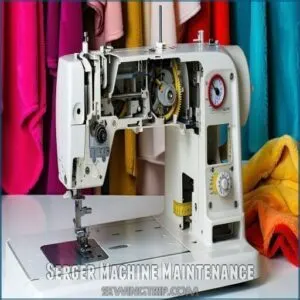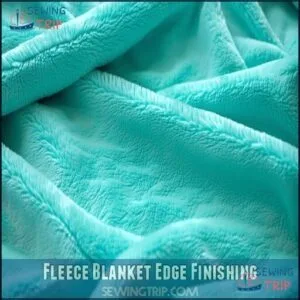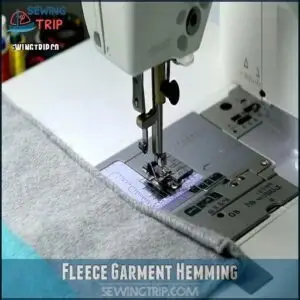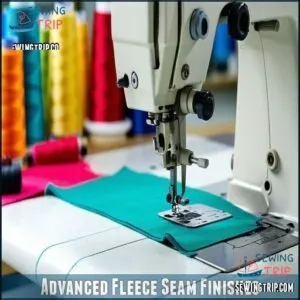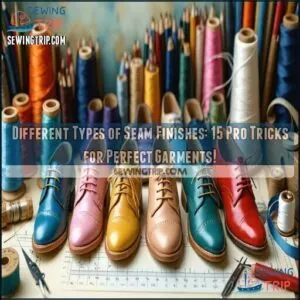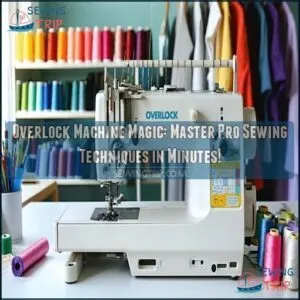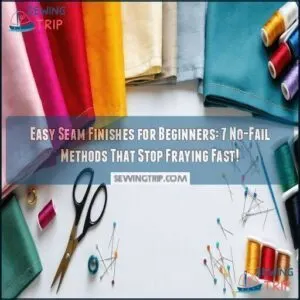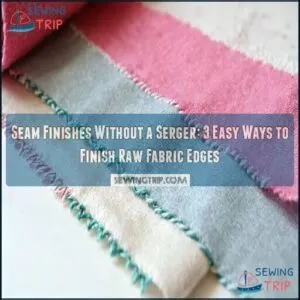This site is supported by our readers. We may earn a commission, at no cost to you, if you purchase through links.
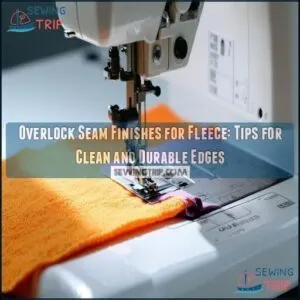
Fleece has a natural resistance to fraying, but an overlock stitch guarantees seams stay strong and tidy.
Use a serger with medium tension and adjust the differential feed to avoid stretching. A three- or four-thread overlock stitch is perfect for most projects.
For extra flair, try a rolled hem or add contrasting thread for a decorative touch—who says functional can’t be fun?
Just remember, fleece is bulky, so trim seam allowances carefully before stitching. Want to level up? Experiment with creative edge finishes to make your fleece projects shine!
Table Of Contents
Key Takeaways
- Use an overlock stitch to give fleece projects clean, durable, and professional-looking edges.
- Adjust serger settings like tension, differential feed, and stitch density to prevent stretching or puckering.
- Trim bulky seam allowances carefully before stitching to maintain smooth and even seams.
- Polyester threads are ideal for stretch and durability when serging fleece.
Fleece Fabric Characteristics
You’ll love working with fleece because it’s soft, warm, and surprisingly easy to manage.
Its unique knit structure means it won’t fray, so you can skip the worry about messy edges.
Fleece Construction Method
Fleece’s unique strength lies in its knitting techniques, where fiber interlocking creates a stable, durable fabric.
Fleece’s knitting magic ensures stable, durable fabric that’s easy to work with and perfect for cozy creations.
Unlike woven textiles, its weave density and pile height make it naturally resistant to fraying.
This fabric stability means fleece holds up well under stress, which makes it perfect for serger stitches and fleece seam finishes. It’s a dream material for overlock pros!
Fleece Fiber Types
In the context of fleece fiber types, you’ve got options.
Natural fleece, like wool, is cozy but pricier. Synthetic fleece, made from polyester, dominates for affordability and performance.
Recycled fleece ups the eco-friendly game, while blended fleece combines the best of both worlds.
A popular choice is polar fleece fabric for winter wear. Each type has unique properties that affect fleece sewing techniques, such as overlock stitch fleece or fleece edge finishing.
Fleece Fraying Resistance
Don’t fall for fraying myths—fleece’s knit structure and fiber locking methods make it naturally resilient.
Even when cut, fleece edges hold up without unraveling, a dream for hassle-free projects.
Worried about tiny thread releases? Here’s the deal:
- Polar fleece won’t fray at all.
- Minky fleece has slight edge thread release.
- Sherpa fleece resists almost everything.
Overlock Seam Finishes
You’ll love how overlock seams can keep your fleece projects looking clean and professional while staying durable.
With the right tools and settings, it’s surprisingly easy to give your creations a polished finish.
Serger Machines for Fleece
A good serger handles fleece like a champ, giving you smooth, professional edges with minimal hassle.
Look for machine brands offering adjustable differential feed and stitch quality suited for fleece overlock.
Pair it with sharp serger needles and specialized thread types for the best results.
Serging fleece transforms raw edges into durable finishes that won’t fray.
Many users find success using a serger machine fleece for these projects, achieving professional edges.
Overlock Stitch Settings
Getting the perfect serger fleece finish depends on the right overlock stitch techniques.
Here’s what to tweak:
- Adjust stitch density—shorter for strong seams.
- Use medium-weight thread and a ballpoint needle for seamless overlock fleece seams.
- Balance overlock tension fleece to avoid puckering.
- Set differential feed fleece to prevent stretching or bunching during sewing.
Thread Options for Fleece
Choosing the right fleece thread elevates your overlock sewing game.
Match thread weight and fiber type with fleece for smooth sewing.
Polyester threads work best for stretch thread needs.
Use color matching to keep seams subtle or go bold with decorative threads.
High-quality threads prevent puckering, ensuring durable edges.
Many sewers find success using specialized fleece options for their projects.
| Thread Type | Best Use | Benefits |
|---|---|---|
| Polyester Thread | General fleece | Durable, stretch-friendly |
| Cotton Thread | Light fleece | Soft, natural finish |
| Elastic Thread | Stretchy fleece | Accommodates flexibility |
| Decorative Thread | Visible stitching | Adds creative seam designs |
Fleece Seam Allowance
When working with fleece, choosing the right seam allowance is key to creating strong and smooth seams.
Seam allowance makes or breaks your fleece project—adjust it for smooth, strong seams that stand the test of time.
It’s a good idea to adapt your allowance based on the fleece’s thickness, so your project doesn’t feel bulky or uneven.
Standard Seam Allowance
When sewing fleece with an overlock, use a standard seam allowance width of ⅜ to ½ inch.
This balance gives you room to serge edges without bulk. Measuring seam allowance accurately with a seam allowance guide guarantees consistent seams.
For fleece sewing tips, remember: match patterns carefully to avoid stretching. Consistent seam allowance keeps your fleece projects looking professional and durable, which is key to a professional finish.
Adjusting Seam Allowance for Fleece
When working with fleece, adjust seam allowance to account for fleece thickness and avoid seam bulk.
For curves, tweak allowance for smooth overlock finishes. Testing allowance on scrap fleece helps refine your sewing.
Pattern alterations may be needed for bulky projects. Slightly wider allowances can improve durability, especially on fleece projects requiring extra strength or softness, and a bit more attention to seam bulk can make a significant difference.
Seam Allowance for Different Fleece Types
Different fleece types impact seam allowance choices. Don’t overlook thickness, stretch, or bulk when planning your seams.
Adjust allowances for smoother sewing and a clean overlock finish:
- Polar fleece needs wider allowance due to thickness.
- Microfleece pairs better with smaller seam allowances.
- Stretch fleece benefits from narrow seams for elasticity.
- Layered fleece calls for careful grading to avoid uneven seams.
Preventing Fleece Fraying
You’ll be glad to know fleece is naturally resistant to fraying, thanks to its unique knit construction.
With a few simple techniques, like using interfacing or seam finishes, you can keep those edges clean and lasting.
Fleece Fraying Causes
Fleece’s construction usually resists fraying, but inconsistencies in fiber density, knit looseness, or stress points can cause yarn slippage.
Poor cutting methods—like dull scissors—might stretch and weaken edges.
Here’s a quick glance at factors below:
| Cause | Impact | Solution |
|---|---|---|
| Fiber Density | Weak edges | Use quality fleece |
| Knit Looseness | Yarn Slippage | Tighter knits preferred |
| Cutting Methods | Jagged, frayed edges | Sharp shears/rotary |
Fraying Prevention Methods
If you’ve ever wrestled with fleece edges unraveling, try a few tricks to prevent fraying.
Use seam stabilizers for durability, or edge binding for a polished touch.
Fray check sealants work wonders, especially on tricky shapes.
Zigzag stitching or a 3-thread overlock can reinforce raw edges effortlessly.
Explore interfacing types to keep seams neat and lasting.
Using Interfacing for Fleece
Adding interfacing can work wonders for fleece sewing.
It boosts fleece stability, prevents stretching, and adds structure without harming the fabric’s softness.
Lightweight interfacing types are best, and you can apply it using a sewing machine or iron-on methods, depending on your project.
When purchasing interfacing fabric, match it to your fleece weight for seamless results, think of it as giving fleece extra backbone, and remember that lightweight interfacing types are ideal for this purpose, as they provide the necessary structure.
Overlock Stitch Settings for Fleece
Getting the right overlock stitch settings for fleece can make or break your project, but don’t worry—it’s easier than it sounds.
By tweaking stitch width, length, and tension, you’ll get smooth, stretchy seams that won’t bunch or pull.
Stitch Width and Length
Finding the right balance with stitch width and length makes all the difference when serging fleece.
Opt for an ideal width of 5-7mm for thick fabrics and reduce it slightly for lightweight fleece.
Keep stitch density tighter—around 2-3mm.
This enhances seam strength and prevents gaps, ensuring your 3-thread or 4-thread overlock stitches securely bind the edges while looking decorative.
Thread Tension for Fleece
Thread tension makes or breaks fleece sewing.
Too tight? Your seams pucker. Too loose? Threads dangle like spaghetti.
For balanced stitching:
- Start with test scraps—adjust tension gradually.
- Match tension to fleece weight—lighter fleeces need lighter tension.
- Use threads suited for overlock finishes, like polyester.
- Check serger settings—aim for smooth, consistent 3-thread overlock stitches.
Differential Feed for Fleece
Your serger’s differential feed is the secret weapon for perfect overlock seams on fleece.
Adjust the feed ratio to prevent wavy edges, especially with stretchy knits. For heavier fleece, test settings around 1.0—lighter fleece might need closer to 2.0.
Wave prevention guarantees smooth stitch quality in both 3-thread and 4-thread overlocks.
Always practice on fabric scraps to ensure the best results with your perfect overlock seams.
Fleece Edge Finishing
In the context of finishing fleece edges, you’ve got plenty of easy options to explore.
From rolled hems to picot edges, each method adds a clean, durable touch without much hassle.
Rolled Hem for Fleece
For a sleek rolled hem on fleece, balance fabric weight and serger settings carefully.
Follow these steps:
- Adjust hem width to suit thicker fleece.
- Set stitch density snugly—3-thread overlock works best.
- Use polyester thread for stretchy edges.
- Test serger settings on scraps first.
It’s like a snug sweater: fits perfectly when prepped right!
Narrow Hem for Fleece
A narrow hem on fleece works well for lightweight projects, but hemming fleece curves can feel tricky.
Use a 3-thread overlock for clean edges, adjusting stitch length for smooth results.
Try thread color choices that blend or contrast boldly.
Secure the hem’s start to prevent unraveling, and for professional results, keep tension balanced and edges trimmed neatly, troubleshooting issues as needed.
Picot Edge for Fleece
For a charming, decorative finish, the picot edge shines on fleece projects, especially when paired with colorful, decorative thread choices.
Suitable for medium-weight fleece, this technique enhances edges without fraying.
Adjust stitch density for a balanced look, and fine-tune tension adjustments as needed, which makes the picot edge a great choice for adding texture and flair, perfect for fleece blankets!
Choosing a Serger Machine
When choosing a serger machine, look for reliable serger brands that handle fleece smoothly.
Consider machine features like adjustable stitch options, durability, and ease of use.
Balance budget considerations with long-term value—cheaper isn’t always better!
User experiences often vary across different serger models.
Check user reviews to see how well the serger works for overlock machine finishes.
A quality serger simplifies achieving clean, professional edges.
Serger Machine Features for Fleece
When picking a serger for fleece, focus on features that make serging smoother.
Look for these:
- Differential Feed: Prevent fabric stretching or puckering during overlock stitching.
- Tension Adjustment: Fine-tune thread tension for clean fleece sewing finishes.
- Sharp Blades and Stitch Options: Guarantee blade sharpness for trimming thick fleece layers effectively, and explore stitch versatility for durable edges.
For best results, consider models with color-coded threading paths for easier setup.
Reliable tools solve half your challenges!
Serger Machine Maintenance
How often do you clean lint out of your serger? It’s key to keeping fleece projects smooth.
Regularly oil mechanisms, replace needles, and handle blade sharpening carefully to guarantee precision.
Don’t skip tension adjustments for neat overlock finishes.
Your serger’s upkeep is like fueling a car—maintain it, and you’ll enjoy seamless sewing machine finishes every time, with regular maintenance being crucial.
Fleece Blanket Edge Finishing
In the context of finishing fleece blanket edges, you’ve got a few simple, reliable options to make them look polished.
Whether you’re using a serger, sewing by hand, or adding a decorative binding, each method can give your blanket a clean and durable finish.
Finishing Fleece Blanket Edges With Serger
Serging fleece blanket edges is a breeze when you’re prepared. Use these tips for clean, durable results:
- Choose Serger thread types suited for fleece.
- Adjust tension for even stitching.
- Use 3Thread Overlock for lightweight blankets, 4Thread Overlock for durability.
- Consider blanket size when planning serger setup.
- Master corner finishing techniques for professional, decorative edge options.
For a simpler approach, consider tied knots as an alternative edge finish, which can provide a clean and durable result.
Hand Finishing Fleece Blanket Edges
Hand finishing fleece blanket edges adds charm and creativity. Try a Blanket Stitch or Whip Stitch for a classic look.
Crochet Edging works great for cozy vibes, while Decorative Stitches bring flair. A simple project sparks endless fleece ideas.
Grab basic supplies, and let your creativity flow—you’ll love the personalized touch!
| Stitch Type | Skill Level | Best Use |
|---|---|---|
| Blanket Stitch | Beginner | Clean, cozy edges |
| Whip Stitch | Beginner | Quick, simple finish |
| Crochet Edging | Intermediate | Warm, decorative details |
Binding Fleece Blanket Edges
Binding fleece blanket edges adds a polished touch to your project.
Use bias binding or satin binding for a smooth, professional finish, especially on blankets with rounded corners.
For a cozy, handmade feel, try crochet edging or a blanket stitch.
Decorative stitches can also elevate the look, making your fleece project ideas stand out. Combine with serging for extra durability!
Fleece Garment Hemming
Hemming fleece garments might seem tricky, but it’s easier than you think with the right techniques.
Whether you’re working on cozy pants or a jacket, a clean hem adds polish and durability.
Hemming Fleece Pants and Jackets
Hemming fleece pants and jackets can be simple if you know the tricks.
For fleece pants, try Pant Cuff Options like folded fleece hems or Elastic Hem Bands for a snug fit.
Fleece jackets benefit from clean Jacket Hem Shapes—folded or with Drawstring Hem Cords for style.
Overlock seam finishes guarantee durable edges while keeping fleece soft and comfy.
Hemming Fleece Blankets and Throws
When hemming fleece blankets and throws, focus on creating a clean, durable finish.
Start with these steps:
- Use serging or overlock stitches for fleece hems, adjusting stitches for weight considerations.
- Round blanket corners for smoother edges.
- Add decorative stitches or fringe options for a stylish touch.
- Match the fleece blanket stitch to the blanket size for proportional, polished edges.
Blind Hemming for Fleece
A blind hem for fleece gives a clean, nearly invisible finish.
Use a blind hem foot to guide stitches perfectly.
Adjust needle type and tension settings for fleece thickness.
Keep hem depth moderate to avoid bulky edges.
Pair serging or overlock for prepping edges.
Stitch visibility depends on practice—so, test first.
Check this quick comparison below!
| Feature | Importance | Tip |
|---|---|---|
| Blind Hem Foot | Essential | Guarantees accurate, hidden stitches. |
| Stitch Visibility | Moderate | Test on scrap fleece first. |
| Tension Settings | High | Adjust for smooth, even stitches. |
| Needle Type | Critical | Use ballpoint or universal needles. |
| Hem Depth | Key | Avoid folding too thick a layer. |
Advanced Fleece Seam Finishes
When you’re ready to take your fleece sewing skills up a notch, advanced seam finishes can give your projects a polished, professional look.
These techniques, like enclosed seams and French seams, add durability and style, even to thick fabrics like fleece.
Enclosed Seams for Fleece
Enclosed seams on fleece are perfect when you want clean, durable edges hidden within layers. They’re great for thick fleece types and help reduce bulk effectively.
Keep seam allowances wide and focus on layer manipulation for smooth sewing.
- Use wide seam allowances to accommodate bulk.
- Trim inner allowances for neatness.
- Select stretchy overlock stitches for durability.
- Test on scrap fleece before starting.
French Seams for Fleece
French seams on fleece? It’s tricky but doable!
For medium-thickness fleece, verify that your sewing machine handles the seam bulk.
Start with small seam allowances to minimize discomfort and improve aesthetic appeal.
The durability factor depends on precise stitching to prevent unraveling.
While fleece’s non-fraying nature helps, French seams shine by adding structure and comfort to lightweight, cozy projects, which is due to their ability to provide added structure.
Hong Kong Seams for Fleece
Hong Kong finishes elevate fleece projects with a polished, decorative touch. Use bias binding to enclose seams, reducing bulk and adding durability.
For best results:
- Choose a binding material that complements your fleece’s thickness.
- Wrap binding around raw edges, ensuring visible seam contrast.
- Stitch carefully for long-lasting, professional-looking results.
This technique combines style and strength, perfect for unlined garments. This finish is often used on soft, fluid fabrics such as silk or rayon.
Frequently Asked Questions (FAQs)
What is the best seam finish for fleece?
For fleece, an overlock seam finish works best.
It trims and seals the edges in one step, giving a clean, professional look.
Plus, fleece doesn’t fray, so you’re already ahead of the game with a clean, professional look.
What is the best stitch setting for fleece?
Think of fleece like a trusty friend—flexible yet strong.
Choose a medium zigzag stitch with 3-4mm width and 5-2mm length.
It’s stretchy enough for movement but tight enough to keep seams secure.
What is the seam allowance for fleece?
Aim for a seam allowance of 1/4 to 1/2 inch when working with fleece.
Its thickness doesn’t fray, but extra room helps with bulk and stability—like giving the fabric breathing space to lay smoothly.
How to avoid bulk in fleece seams?
Keep fleece seams lightweight by trimming excess fabric and opting for flat, open seams.
Use a 3-thread overlock or zigzag stitch, and skip interfacing—it’s just extra baggage for a fabric that doesn’t fray!
Best needle type for sewing fleece fabrics?
Imagine stitching a cozy fleece blanket and struggling with skipped stitches.
Use a 90/14 ballpoint needle—it slides through fleece effortlessly, preventing snags and frustration.
Trust me, it’s a needle every fleece-lover needs.
Can stretch overlock stitches work on fleece?
Yes, stretch overlock stitches work great on fleece.
They provide durability and flexibility, perfect for fleece’s stretchy nature.
Pair it with polyester thread, and you’ll get sturdy seams that move comfortably with the fabric.
How to stabilize stretchy fleece during sewing?
About 80% of fleece is made from stretch fabric, so stabilize it by using lightweight fusible interfacing or a ballpoint needle.
Pin generously and avoid stretching as you sew—think of it as gentle persuasion, not wrestling.
What thread types enhance fleece seam durability?
Polyester or all-purpose threads work great for fleece since they’re strong and flexible.
Wooly nylon threads are ideal for overlock finishes, offering extra stretch and durability, especially for activewear or cozy projects.
Stick to stretch-friendly options!
Conclusion
Think of overlock seam finishes for fleece as the glue that holds your projects together—strong, tidy, and dependable.
By mastering your serger’s settings, like tension and differential feed, you’ll prevent stretching and create seams that last.
Don’t forget to trim bulky allowances and play with decorative threads for a polished look.
Whether it’s a rolled hem on a blanket or clean edges on comfy garments, these tips guarantee your fleece creations shine with professional craftsmanship.

